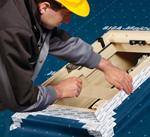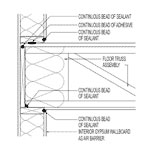Justin: Stopping air leaks is the single most important part of making a house more energy efficient. You can stop air on the outside with plywood, housewrap, and tape, but the best air barrier is more of a system that incorporates all the components of a wall or roof assembly.
We decided to drywall the garage shop in Fine Homebuilding’s project house using the Airtight Drywall Approach. Partly to show our readers how to do it and partly so that we could make Myron Ferguson do our dirty work for us.
The outside of the house will eventually be covered with housewrap and foam sheathing, so the drywall is not the primary air barrier; it is part of a larger system.
Myron: When it comes to materials, drywall is going to be our chief component in making the interior of this wall and these ceilings airtight. Drywall makes a nice air barrier because it’s a relatively solid piece of material. The only place you have potential air leaks is through little openings or along seams or inside corners. I’m comparing this to, say, a knotty pine tongue-and-groove ceiling. Now that’s not an air barrier at all. It’s just full of holes. So drywall to start out with is going to be a very good air barrier.
Justin: The other main materials Myron uses in this project are pretty common on most job sites: construction adhesive, latex caulk, and canned foam. Some other materials are a little less common on job sites: mainly foam boxes for sealing electrical outlets.
Myron: A good practice for any drywall job, regardless of whether you are going to do airtight drywall, is to walk through with a building contractor a few prior to the delivery of the drywall. That way you you can identify any potential problems and all that can be corrected before you actually do any drywall work.
Justin: This garage has a 2×6 bottom plate, but 2×4 studs. Before Myron came out, we placed blocks in each stud cavity because without blocks to glue the bottom of the drywall sheets to, a considerable amount of air could flow through the wall assembly.
If not already done at the pre-construction walk-through, seal all of the gaps between framing members.
Around windows, around doors, and at the gaps between king stud and trimmer, between header and top plate, and between the double – or, in this case, triple – top plates.
Myron: If the gap is wider than 1/4 inch, it’s a good idea to use spray foam instead of the caulking. It’s important to use flexible caulk, because you don’t want to use a caulk that will dry out and shrink, or maybe not even stretch and move should the structure expand and contract, because we don’t want these gaps to open up. Then there would be a passage for the air. We’ve done all the air sealing that we can at this point, so we’ll start to hang the drywall. We’re going to start with the ceiling.
If you are a GBA Pro member, click here to see episode 2: Video: How to Hang Airtight Drywall (2 of 3).








5 Comments
Fiberglass
People still use fiberglass?
Response to Jason Peacock
Jason,
Fiberglass batts are the most common residential insulation material in the country -- by a long shot.
Toxic construction materials
I'm very aware of this. I think that common residential construction is a comedy of errors. There is so much room for improvement. I wish that fiberglass batts were illegal and that you had to have a certification, similar to Lead Paint, to work with them. We've got so many toxic construction materials that a majority of homes are built toxic, without a lot of thought put into it. Things are changing but ever so slowly and unfortunately cost wins out a majority of the time. You get what you pay for.
Fiberglass
More than 90 percent of homes in America are lined with the pink stuff called fiberglass.
It is actually capable of causing immediate skin irritation and while some research suggests that inhaling fiberglass particles could cause cancer, in 2001, the International Agency for Research on Cancer removed glass, rock and slag wool fibers -- common elements of fiberglass insulation.
Illegal?
Fiberglass glass batts may pose a health risk of installers who refuse to follow mandated safe work practices, but there is no evidence they are harmful in a finished house.
Log in or create an account to post a comment.
Sign up Log in